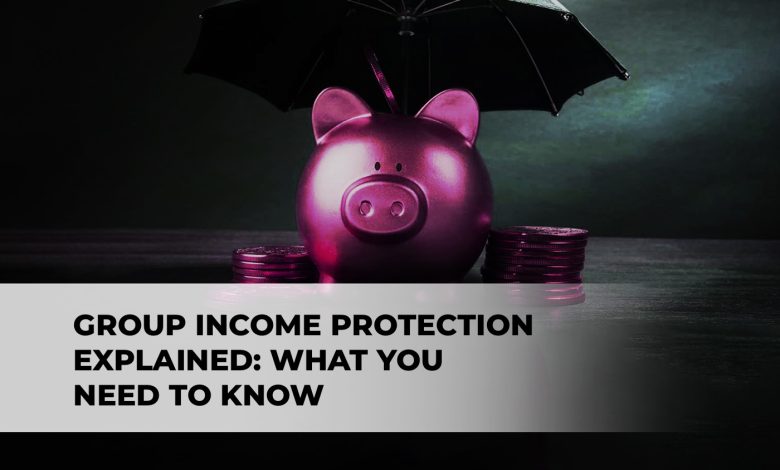
Group income protection is a crucial employment benefit that gives both companies and employees peace of mind and financial stability. Group income protection guarantees that an employee will continue to receive a percentage of their wage if they cannot work due to a long-term illness or injury. This allows them to maintain their level of living and pay for any essential expenses. We’ll examine group income protection in more detail in this article, including what it is, how it functions, and what you need to know to decide if it’s the best choice for you and your team.

What Is Group Income Protection?
An employee benefit called group income protection offers financial assistance to workers who cannot work because of chronic illness or accident. It assists people in paying their living expenses when they are unable to work by disbursing a portion of their earnings for a predetermined time.
Typically, employers buy group income protection policies from insurance providers and provide them to their staff as a benefit. Although employees might also be required to contribute, the employer typically pays the cost of the policy. An employee may submit a claim under the group income protection policy if they are unable to work due to illness or accident. For a predetermined amount of time, the policy will typically pay out a portion of the employee’s salary, frequently up to 60–70%. The insurer and the particular policy that the company selects will determine the exact provisions of the coverage.
Employees benefit greatly from group income protection because it assures them that even if they cannot work due to illness or injury, they will continue to receive a monthly paycheck. Employers can use it to support workers unable to work due to health concerns and attract and keep talented staff.
Features and Benefits of Group Income Protection:
Group income protection offers a range of features and benefits for both employers and employees. Here are some of the key features and benefits:
Features:
- Regular Income: Group income protection guarantees that an employee will continue to receive a regular income, often a percentage of their wage, for a predetermined amount of time if they are unable to work due to a long-term illness or injury.
- Rehabilitation Support: Access to rehabilitation services is frequently made available through group income protection policies, which can assist employees in returning to work more quickly and cutting down on the length of their leave.
- Mental Health Support: Support for mental health difficulties, such as counseling and access to mental health professionals, is a common feature of group income protection programs.
- Flexible Benefit Packages: Employers frequently have the option to customize their group income protection policies by selecting the level of coverage and the duration of the benefit payout period to meet the demands of their company and their employees.
Benefits:
- Financial Security: The knowledge that they will continue to receive a regular income even if they are unable to work due to illness or injury gives employees financial stability and peace of mind.
- Improved Morale: Giving employees group income protection as a benefit can increase morale and show that a company cares about the health and happiness of its workers.
- Attracting and Retaining Talent: Group income protection is a useful perk that can assist employers in luring and keeping exceptional workers, particularly in areas with fierce competition.
- Reduced Absenteeism: Group income protection can help to shorten the length of employee absences and speed up their return to work by giving them access to rehabilitation programs and mental health support.
How Does Group Income Protection Work?
We talked about what group income protection is, what it does, and what its benefits are, but how does it work? Let’s talk a little bit about that as well.
- Employer purchases the policy: The employer chooses the level of coverage and duration of the benefit payout period when purchasing a group income protection insurance from an insurer. Although employees might also be required to contribute, the employer is typically responsible for covering the cost of the policy.
- Employee is unable to work due to illness or injury: When an employee becomes permanently ill or injured, they notify their company and file a claim with the group income protection insurance.
- Waiting period: Most policies include a waiting period between 1 and 26 weeks before benefit payments begin. This waiting period allows the worker to heal from any minor ailments or injuries and go back to work without needing to file a claim.
- Payment period: The group income protection policy will begin paying out a regular income, often a portion of the employee’s salary, for a set amount of time if the employee is still unable to work after the waiting period. This time frame can be anything from a few years to the employee’s retirement age.
- Rehabilitation support: Many policies provide rehabilitation services, which can shorten an employee’s absence and speed up their return to work. This may include access to occupational therapy, counseling, or physical therapy.
- Mental health support: Some laws also offer assistance for mental health problems, including counseling and access to mental health specialists.
- Policy ends: When the employee returns to work, becomes retirement age, or the predetermined benefit payment period expires, the group income protection policy normally comes to an end.
It’s crucial to remember that the specifics of the policy will change depending on the insurer and the particular one the business selects. When choosing a group income protection policy, employers should carefully consider the needs of their company and their employees. They should also consult with an expert insurance broker to determine the appropriate level of coverage.
How to Choose the Best Group Income Protection Policy for Your Employees:
Choosing the right one for your employees might be difficult for some employers, so we made a little guide for you to make things easier. Here are some factors to consider when choosing a policy:
Identify Your Employees’ Needs:
It’s crucial to determine the unique needs of your employees before choosing a group income protection policy. Think about things like your company’s nature, your team’s makeup, and any employee benefits you now provide. You may also wish to speak with your staff or perform a poll to understand their demands better.
Compare Policies:
After determining the needs of your staff, you may begin evaluating insurance packages from various companies. Consider elements including the extent of coverage, the duration of the benefit payment term, and any extra benefits like mental health and rehabilitation assistance. It’s crucial to take into account the policy’s cost as well as any exclusions or limitations.
Work with an Experienced Insurance Broker:
Working with an expert insurance broker who can guide you through the possibilities and help you discover the best policy for your company and your employees is essential if you want to make the best choice possible for group income protection. You may compare policies, evaluate your needs, and bargain with insurers to acquire the best terms with the aid of an insurance broker.
Review and Update Regularly:
After selecting a group income protection policy, it’s crucial to periodically review and update it to ensure it still meets your employees’ needs. Your insurance requirements may vary as your company and staff develop, so keeping informed and modifying your policy as necessary is critical.
Final Words:
Group income protection is an essential benefit that might help safeguard employees’ financial security in the case of chronic illness or injury. Employers should consider their workers’ unique demands and consult with a knowledgeable insurance broker to determine the appropriate degree of protection. Group income protection helps employees stay employed by ensuring a steady income when they are unable to work, which can ease the financial strain and keep talented workers happy. To make sure their policy continues to fulfill the needs of their employees, employers should evaluate and update it frequently. In general, collective income protection is effective for fostering monetary stability and overall well-being at work.







